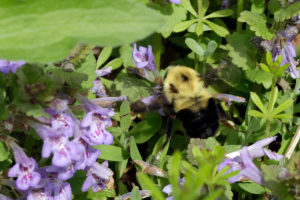 As we rejoice at the onset of summer with the next wave of blooming fruit trees and flower beds bursting to life, we think about how good it is to live here. We enjoy the beautiful Lake bordered by lots of green landscape with flowers as frosting on the cake. Some of us are already busy looking for insects among all that, especially the pollinators like butterflies and bumblebees.
As we rejoice at the onset of summer with the next wave of blooming fruit trees and flower beds bursting to life, we think about how good it is to live here. We enjoy the beautiful Lake bordered by lots of green landscape with flowers as frosting on the cake. Some of us are already busy looking for insects among all that, especially the pollinators like butterflies and bumblebees. Last time I talked about the early blooming plants which sustain bumble and other bees just after they emerge from their winter dormancy – the willows and weeds that bloom as soon as it starts to warm. I think we’ve all heard of “No Mow May” as a way of helping provide flowery resources for pollinators, but I wonder how many people actually don’t mow for the entire month. I’m not able to get past the middle of the month, lest my lawn become an absolute hayfield, un-mowable with my little lawn tractor. Last year, my uncle next door had a mower break down and I mowed his lawn in late May and it was a disaster – actually took several mowings and put a lot of strain on equipment.
So I would like to propose an alternative to No Mow May, which would require no additional effort on the homeowner’s part. It would have three components:
1. Set your mower to its highest height. Even the highest setting on most mowers is about 3 inches or so, not terribly high compared to native grasslands.
2. Don’t use herbicides or insecticides on your lawn, except if you choose to save an ash tree in your yard. Although treating ash trees would be toxic to insects which feed on ash in addition to the ash borers, as ash disappear they would lose that food source anyway. Avoiding lawn herbicides requires us to be tolerant of non-grass plants- in my lawn are creeping charlie, dandelions, white clover, common and narrow-leaved plantains, and other plants. They adapt to grow low, and survive mowing, providing flower resources for bees and others all summer. Minnesota Vikings or Two Rivers Raiders fans will appreciate the splash of purple and yellow in the yard. Yes, they are non-native plants, and can be invasive, but your lawn is not a pristine natural area. Turf grass is non-native and invasive, so if you’re going to have non-natives at least they should be a food resource for beneficial pollinators. Of course, you may not want an entire lawn of creeping charlie, but better to control it in the fall after pollinators are done for the year.
3. Mow a little less. Every year I try to figure out how to make my lawn smaller. I live on about 20 acres and could make my lawn that large if I wanted. Of course, I don’t want a large lawn, and am working to have what I consider a reasonable lawn framed by prairie and wildflower plantings. My lawn has been getting slightly smaller each year for the last five years. I realize that I’m fortunate to not have close neighbors which might be offended, but whatever your situation I encourage you to think about how you might “cut down” a bit on mowing. The benefits to nature are obvious.
I think the key to long-term environmental improvement and sustainability is to find ways to work with nature which are easy. Less work, less gas for mowers, and less pesticides results in a more liveable world. And, I find happiness in walking over my yard looking for bumblebees and others which I know are struggling to survive in other places. I hope you do too.
photo- a two-spotted bumblebee on creeping charlie at UW-Madison Arboretum, from their webpage
